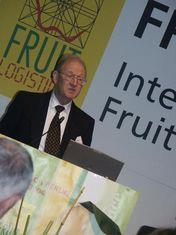
Fruit Logistica was told that in 2003, EU fruit and vegetable production amounts to 79 million tonnes, valued at 33 billion euros.
Dr Wilhelm Ellinger, director of the fruit division, Zentrale Markt - und Preisberichtsstelle GmbH (ZMP), Bonn, reported, that the production stage in the EU currently comprises some 1.5 million businesses involved in the cultivation of fruit trees and fruit bushes on an area measuring 1.4m hectares. A further 750,000 production units are engaged in growing vegetables, including melons and strawberries, occupying 1.8mha.
Last year, 29mt of fruit were grown in the EU, although climatic influences in the form of frost damage and prolonged dry spells were responsible for a shortfall compared with 2000 (33mt). There were declines in the amounts of apples, peaches/nectarines and strawberries produced, whereas citrus fruits remained stable.
At the start of the new millennium, vegetable production reached a new high of 52mt and since 2001 has remained stable at 50mt. There has been a noticeable decline in the extensive, outdoor production of certain vegetables such as sweet corn, peas, beans and spinach, which are intended mainly for processing. Tomatoes are by far and away the most important vegetable.
Taking as a sum total the production in the EU and the foreign trade balance we obtain a market volume for items intended for the fresh produce market amounting to 29.9mt in the case of fruit and 33.7mt for vegetables, said Ellinger.
In 2002 fruit had a total production value of €10.3bn, and the figure for vegetables was €22.6bn. Taken together, these two sectors have a production value roughly equivalent to that of cereals. According to initial, provisional estimates from Eurostat, in 2003 there was a two per cent increase in the production value of fruit in 2002, and a five per cent rise in the case of vegetables.
Trade in fresh fruit and vegetables in the EU
There is a massive negative balance of trade in fresh fruit with third countries.
Each year some 20mt of fruit and vegetables (12mt of fruit and 8mt of vegetables) are traded between member states of the EU. Exports totalling 4mt (2.6mt of fruit and 1.4mt of vegetables) compare with imports of 9.1mt (8mt of fruit and 1.1mt of vegetables).
The EU is dependent on imports of fruit from tropical regions and approximately half of its imports are of tropical fruit, 2.5mt of which come from countries in the southern hemisphere with moderate to sub-tropical climates.
Of the fruit exported by the EU, which totals 2.6mt, 70 per cent is destined for the countries of central and eastern Europe. Following the imminent expansion of the European community, however, 40 per cent of what were exports to third countries will become classified as internal trade.
In the case of fresh vegetables the balance with third countries is more or less equal. At 350,000t, onions represent the main import from third countries. Roughly one third of vegetable imports come from countries bordering the Mediterranean, such as Morocco and Turkey, while around 15 per cent are from central European countries, including Poland and Hungary. Onions (also 350,000t) and tomatoes (200,000t) are among the leading exports. The largest market for this produce is in eastern Europe, chiefly Russia. The EU countries on the Mediterranean, together with the Netherlands with its greenhouses, are able to meet much of the demand during the long Eastern European winter months. Apart from eastern Europe, during the six coldest months of the year EU onions are also exported to many countries in Africa, Asia and the Caribbean.



